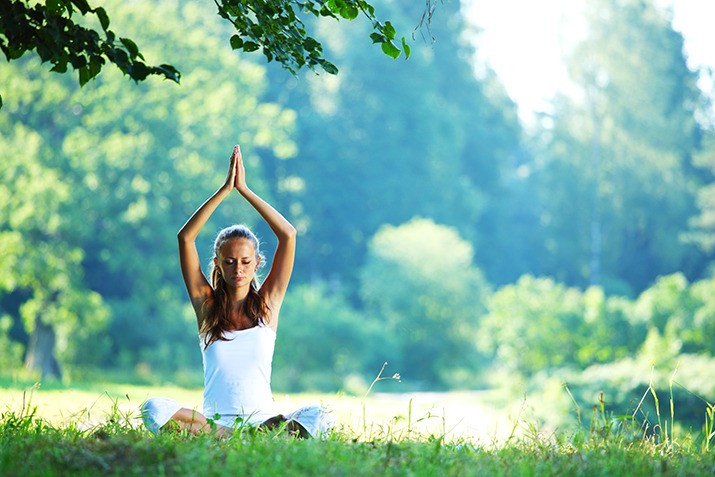What’s Missing from Your Yoga Practice?

Yoga is currently one of the most popular forms of exercise in the world. Celebrities tout its benefits on late night TV shows, corporations, schools, and even jails have instituted yoga programs, and there is a whole business dedicated to designer yoga clothes and accessories. There is even baby yoga! But this popularity makes sense when you understand how valuable a tool yoga is for your wellbeing. Yoga improves digestion, immune function, flexibility, strength, joint pain, anxiety, sleep, sex, focus, memory, self-esteem, inner peace, and connection to Source, just to name a few of its dozens of benefits. But if you want to get the most out of yoga, consider adding a missing ingredient that will take your practice to new heights: Ayurveda.
In Sanskrit, the word “yoga” means “to join together” or “union,” and comes from the same roots as the word “yoke,” as in two things yoked together. In yoga, the yoking is in reference to the union of mind, body, and spirit. The word Ayurveda comes from the Sanskrit roots Ayu, meaning “life” and Veda¸ meaning “knowledge” or “science.” So Ayurveda means the “science of life.” Some scholars suggest that Ayu doesn’t just mean life, but even more specifically, the state of being in which mind, body, and soul are joined together and there is total integration. This unity and connectedness is the goal of both yoga and Ayurveda—and energy healing—and every step toward that unity dramatically improves your quality of life.

What Is Ayurveda?
Ayurveda is a system of medicine that’s over five thousand years old, even older than traditional Chinese medicine. This “science of life” originated with ancient seers called rishis. These enlightened men and women sat for hours in deep meditation, communing with what they called the “Cosmic Consciousness,” and what we in energy medicine call the universal field. This unified field or Cosmic Consciousness or Source or whatever you want to call it holds the past, present, future, and all information in existence, and these rishis returned from their meditations with beyond-earthly insight into the world. They turned this insight to the human body and “discovered” the healthcare system of Ayurveda.
The rishis in their infinite wisdom discerned that the energy from the universal field manifests itself in all matter—including humans—as five basic elements: air, fire, water, earth, and ether or space. Within the body, those basic elements come together in different combinations to make up three biological or metabolic bio-energies, which Ayurveda calls doshas. There are three doshas: the space and air elements combined to form the Vata dosha, the fire and water elements combined to form the Pitta dosha, and the earth and water elements combined to form the Kapha dosha. Each person has a unique mind-body constitution, or prakruti, which means “nature,” that is their body type. Your prakruti is based on which dosha(s) are most prevalent in you.
These doshas are super important, as they are the bridge between the body and mind, the spot where your thoughts turn into matter, and here, you can see the first signs of health problems and treat them before they develop. Ayurveda is a lot like energy medicine—it’s why they can work in tandem so well—as it is the imbalances in the energy that cause physical problems. By following Ayurvedic principles and rebalancing the doshas, you can restore your body to health and reestablish the mind-body-soul connection.
How Do Ayurveda and Yoga Work Together?
Just like Ayurveda, the governing principle of yoga is balance, and both traditions have healing properties. They have even been called “sister sciences.” When yoga was first brought to the west, Ayurveda was left out, even though both practices were born out of the larger tradition of Vedic knowledge in ancient India. When you bring these two modalities together again, you’ll understand why they were made to be yoked.
Yoga on its own is not a system of medicine, but rather a spiritual practice and type of treatment. It heals, but does not diagnose. For that, you need a system of medicine which has a clear understanding of how the body and energy field work. That’s what Ayurveda does—allows you to understand the cause of the problem so you can assess, diagnose, and then treat.
Think of it this way: energy healing is a system of medicine just like Ayurveda. An energy healer can sense your problems and chakra blockages and suggest a course of treatment, which can include meditation, journaling, grounding, chakra clearing, etc., but you need that umbrella of energy medicine to first evaluate and diagnose your issue and then recommend the curative measures. Directed efforts are more effective, and that requires a diagnosis.
This is how Ayurveda can take your yoga practice sky high—by tailoring your yoga therapy to address the issues identified through Ayurveda, you turn yoga into a targeted healing machine for your unique constitution. There are yoga postures that correspond to specific doshas, and once you learn those, you will be amazed at how much more you’ll get out of your yoga practice. You’ll come away feeling more refreshed and with a deeper internal peace.
Touch Heaven & Earth
This doesn’t mean you can’t take your regular yoga class. People who have different prakrutis are in classes together every day. What you can do is alter your poses to address your personal needs. Attitude and intention go a long way in all these healing therapies—yoga, Ayurveda, energy healing—and yoga is a place to follow through with your intentions. Your body and spirit are different from everyone else’s so why should you do your asanas the exact same way? Aligning your practice with your Ayurvedic constitution will boost your results tenfold.
So if you’re a Vata, try practicing more slowly and deliberately; if you’re a Pitta, try to relax into your asanas and avoid overheating; if you’re a Kapha, challenge yourself! Go for those tough poses. If you don’t know your dosha, consider working with a spiritual teacher or taking healing courses or an online quiz. And if you don’t already practice yoga, I encourage you to start! Like meditation, it’s most effective when done regularly.
Let me leave you with this idea: Ayurveda is the physical health counterpoint to the spiritual act of yoga. Yoga is for reaching higher states of consciousness and Ayurveda is for reaching balance on the physical plane. Done together, you can touch heaven and earth and heal yourself in the process.

